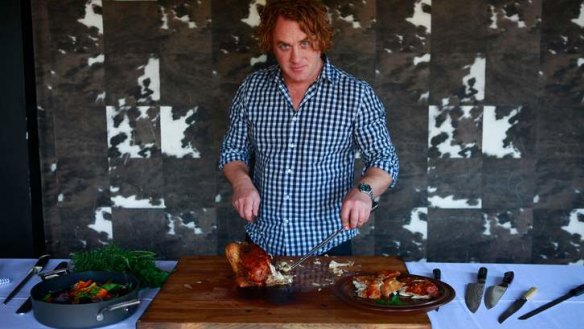How to carve a roast
The task of carving the roast lamb or chook should not be left to an amateur this Christmas. According to chef Adrian Richardson, carving is a skill akin to performance art. He shared his tips with Justine Costigan.

Carving meat at the table should be a great culinary performance. Chef, cookbook author and meat-guru Adrian Richardson says the meat should be placed at the head of the table where everyone can watch the process. It's the privilege of the carver to help themselves to the choice pieces of meat but he says you need to be cunning or small children will pick off those delicious, crunchy morsels before you get to them.
Before you start
Resting meat
The only way to guarantee a tender and juicy piece of meat is to let it rest for half the time it has been cooked. Meat can be returned to the oven briefly to warm it through before serving, if desired.
Carving tools
A carving fork and good carving knives are essential. Make sure you test any knives before you buy them - a good knife will feel right in your hands and will last a lifetime if you look after it. It's worth the initial investment. Make sure your knives are sharp. If you're not sure how to sharpen a knife ask your butcher for tips or check out DIY knife sharpening clips on Youtube. Always store your knives properly. A traditional carving board is useful as it will often come with a trough to catch the meat juices but a big chopping board is also a good alternative.
Carving
Roast chicken / turkey
The principles of carving a chicken can be applied to most poultry including turkey.
Start by lifting your bird from the roasting tray where it has been resting to a board. Have a serving platter ready. A carving fork or tongs are the best tools to use. If the chicken has been trussed remove any string and discard.
Remove the whole leg (drumstick and thighs) by cutting through until you find the hip bone, then slide your knife behind the bone and cut through the thigh. To separate the thigh from the drumstick, simply twist the drumstick away from the thigh. The thigh can also be cut into two pieces by cutting away from the bone – keep the bone for any family member who loves to chew on them.
Breast meat: Find the backbone of the chicken and cut down alongside the bone until the breast come away whole. Place the breast on your board and cut into nice even pieces. You'll get about 6 pieces per breast from an average chook.
Twist the wings from the bird using your carving fork (get your butcher to remove the wishbone for you to make it even easier).
Repeat the whole process on the other side of the chicken.
If you have any stuffing or cavity juices spoon them onto your serving plate. Pour any juices left on the carving board over the meat.
If there's any meat left on the bird, pick it off and add it to your serving platter. Use leftover bones and meat to make a simple chicken stock.
If you're nervous about carving a turkey on Christmas Day while everyone watches your every move, practise your carving technique in advance on a roast chicken.
Leg of lamb
Lift the leg of lamb from its roasting dish onto a carving board. You need to carve across the grain of the meat so make sure the lamb is in a good position to do this. The grain goes along the bone, but if you're still unsure remember meat carves more easily and smoothly across the grain.
Put your carving fork into the lamb at a slight angle a short distance back from where you would like to start carving. Slice the meat thinly gradually moving the fork as you go.
When you reach the bone, change the position of the knife and fork and use the fork to help balance the knife as its slices across the bone.
Only carve as much as you need. Once meat has been sliced it will dry out so leave the meat on the bone, in the fridge, until you decide what to do with any leftovers.
Lamb should not be too rare, a blush of pink in the middle is perfect. Lamb that's too rare will be chewy.
Ham
Choose a flexible carving knife with a finely serrated edge as it is the best for cutting very fine slices. Large serrations will tear the meat.
Decide where you would like to begin (a nice round part of the ham is a good choice) and cut away the glazed skin until you reach the meat. Keep all these lovely crunchy bits to serve with your ham.
If you're slicing a cold ham – cut a flap of fat and skin away and fold it back from the meat. Don't separate it completely as the flap will help keep the ham moist when stored.
Insert the carving fork at an angle a few places back from where you want to carve. Begin slicing, gradually moving the fork back as required.
For ham on the bone see the roast lamb carving tips for slicing tips.
Once you've finished slicing in one direction, turn the ham to another positon.
Cut only what you need and store your ham leg in a ham bag in the fridge.
Share your carving tips, triumphs and disasters in the comments below.
Adrian Richardson's restaurant La Luna Bistro is at 320 Rathdowne Street, Carlton, (03) 9349 4888, lalunabistro.com.au.
Appears in these collections
From our partners
Original URL: https://www.smh.com.au/goodfood/how-to-carve-a-roast-20121211-2b6gp.html